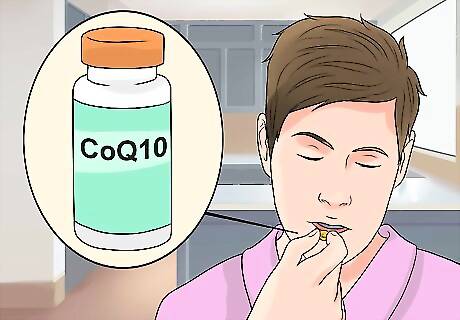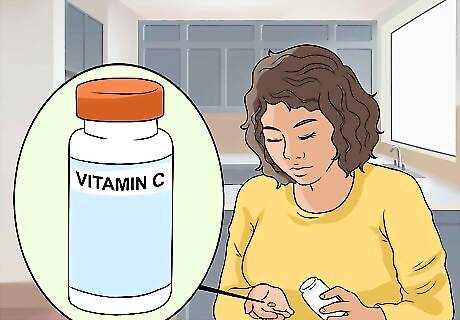
views
X
Trustworthy Source
National Institute of Diabetes and Digestive and Kidney Diseases
Health information from the National Institute of Diabetes and Digestive and Kidney Diseases, a division of the U.S. National Institutes of Health
Go to source
Treating Insulin Resistance Through Diet and Exercise

Choose complex carbohydrates. 90 to 95% of your daily carbohydrates should be complex. Complex carbs take longer for your body to process because they're more complicated on a molecular level. This gives your body a better chance to process the glucose. Complex carbs are found in whole, unprocessed foods like whole grains, peas, lentils, beans, and vegetables. Simple carbohydrates are often found in processed foods (which include added sugars like glucose, fructose, and sucrose) and are quickly broken down by the body.

Reduce your sugar intake. Sugar itself does not cause diabetes, but ingesting more sugar-filled beverages (especially those containing high-fructose corn syrup) for example is linked higher blood sugar levels and to an increased risk of Type 2 diabetes. Avoid any added sugars and try to choose unprocessed foods. You'll need to read labels carefully to determine the amount of sugars in a food. Make sure to check the labels for all products you buy, since sweeteners are often used many products. To make it simple, you can avoid "white" foods. Don't eat white bread, white pasta, or white rice, in addition to desserts or sweet treats. Understand that manufacturers are not required to list added sugars on the label.

Avoid processed foods. Processed foods should be avoided because they include both simple carbohydrates along with added sugars. Your food should be as whole and natural as possible. Cut back on processed or prepared foods and cook from home as much as you can. This way you can control food quality and additives like sugar and fat.

Eat more fiber. Fiber, along with whole grains, can reverse type 2 diabetes, according to research. Try to include fiber along with every meal. An easy way to get fiber is to sprinkle a tablespoon of ground flaxseed over your meal. Other good sources of fiber include: Brans: corn bran, oat bran, wheat bran Beans: navy beans, lentils, black beans Berries: strawberries, raspberries, blackberries Whole grains: bulgur, brown rice, barley, oats Vegetables: peas, leafy greens, squash Seeds and nuts Fruits: pears, prunes, figs

Include more fruits and vegetables. Eat more fruits and vegetables of all varieties and colors for the most nutrients. You shouldn't avoid eating fruit because of their sugar. The sugars in fruit are combined with fiber so your body slowly absorbs the sugar. Dried fruit contains more sugar than its fresh counterpart, so try to include more fresh fruits. Berries are one of the best choices.

Eat lean proteins. Choose fish and skinless poultry. The skin can be high in animal fat and added hormones and antibiotics. Eat a few helpings of wild-caught fish each week. Look for salmon, cod, haddock and tuna. These are all good sources of protein and omega-3 fatty acids which are anti-inflammatory. While red meats don't contain carbohydrates that could raise your blood sugar, you should still limit the amount of red meat you eat. Red meat may raise your cholesterol.

Incorporate exercise. In addition to improving your diet, treatment of insulin resistance includes regular physical activity. Aim for 150 minutes of moderate exercise each week (or 30 minutes five days a week). You can also increase your baseline activity level by doing small things like taking the stairs instead of the elevator or parking your car farther from the door. Do not jump into a rigorous exercise routine if you are out of shape or have not exercised in a while. Speak with your doctor about what is appropriate for you and ease into activity.
Taking Herbs and Supplements

Consider your risk for insulin resistance. Several factors can overwhelm the natural balance of blood sugar, leading to too many periods of hyperglycemia (high blood sugar) followed by periods of hypoglycemia (low blood sugar). These factors include eating too many simple sugars, having a family history of diabetes, obesity, and a lack of exercise. Eventually, blood sugar imbalance can weaken your blood sugar control system, leading to insulin resistance and diabetes (after months to years of insulin resistance).

Talk with your doctor. If you are concerned about your blood sugar levels (perhaps because diabetes runs in your family), see your doctor. Inform your doctor of any lifestyle or diet changes you've made to control your blood sugar. You should be seeing your doctor for regular checkups and blood tests if you're trying to prevent diabetes. In some cases, medication may be able to help you reverse insulin resistance. Remember to ask your doctor before taking herbs or supplements, including minerals. High amounts of trace minerals can cause toxicity, so always follow the doctor's and manufacturer's advice concerning dosage.

Cook with herbs to control your blood sugar. There are a large number of herbs that you can add to your diet to help control blood sugar levels. Use them to flavor your meals since they are safe with no side effects. These herbs may help you get over some of those sugar cravings as well. Try: Cinnamon Fenugreek Okra (not quite an herb, but more of a side-dish) Ginger Garlic and onions Basil

Add herbal supplements to your diet. Studies have shown several herbal supplements may improve glucose tolerance. Try bitter melon which prevents the intestines from absorbing sugar. Or, take the coptis chinensis supplement which comes from plant roots and is shown to increase the body's responsiveness to insulin. You can also include a gymnema sylvestre supplement which supports the pancreas in producing insulin. Some of these herbal supplements, like bitter melon, may interact with other glucose-regulating medications. Always talk to your doctor before introducing a supplement.

Take antioxidants. Take alpha-lipoic acid (ALA) and CoEnzyme Q10 (CoQ10). These antioxidants may control blood sugar levels. ALA stabilizes blood sugar levels and CoQ10 is an antioxidant produced in all cells. CoQ10 levels are lower in diabetics, so supplementing may reduce your risk of the disease. You may want to take carnitine, which comes from amino acids. Carnitine can control blood sugar and blood fats by converting fat into energy.

Use an omega-3 fatty acid supplement. Healthy fats like omega-3s can reduce the inflammation caused by high blood sugar levels and may. Consider taking an omega-3 fatty acid supplement, evening primrose oil supplement, or flaxseed oil. These are all good sources of healthy fats. Research has shown that omega-3s work well when combined with additional treatment for insulin resistance.

Take a vitamin supplement. Several B-vitamins work to regulate glucose, prevent nerve damage, and prevent cholesterol. Look for biotin (a B-complex), niacin (another B-complex vitamin), vitamin B6, and vitamin B12. You may want to include a vitamin C supplement because it can reduce insulin resistance. Vitamin D may also be helpful in improving insulin sensitivity. Always follow the manufacturer's dosing instructions for vitamins. Include minerals in your supplement. Several important minerals can maintain blood glucose levels. These include magnesium, zinc, chromium, vanadium, potassium, manganese, and selenium.




















Comments
0 comment